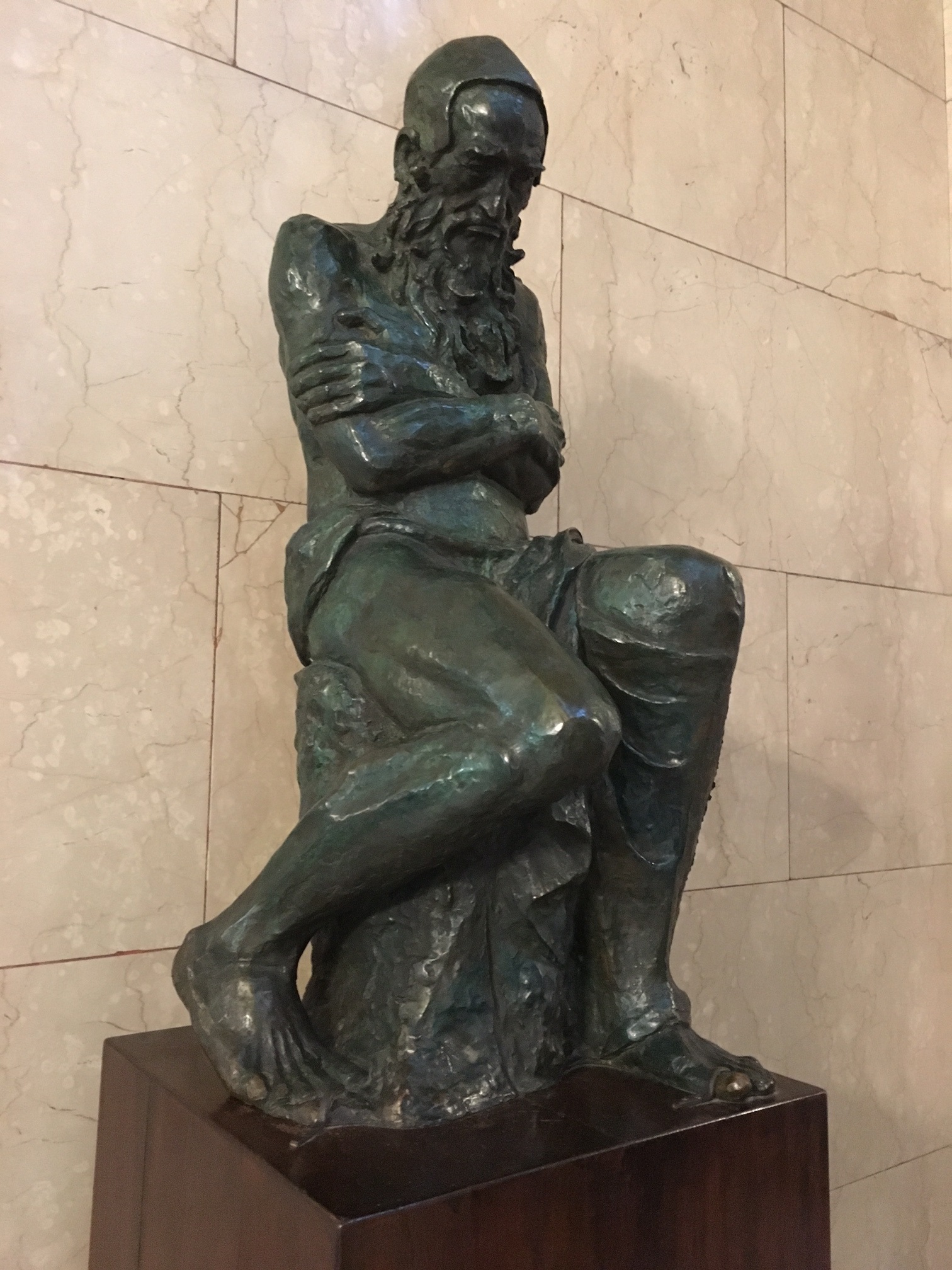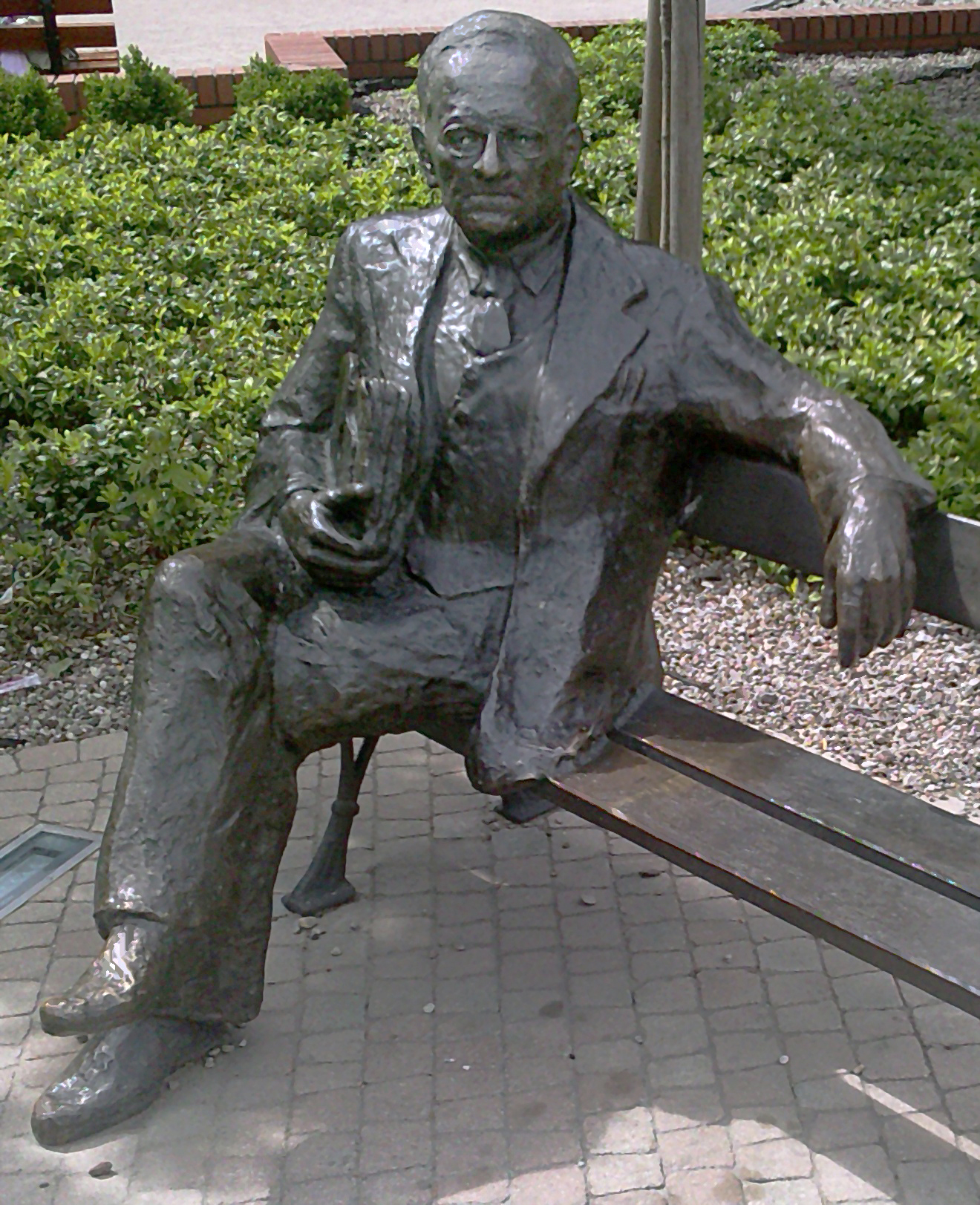|
Enrico Glicenstein
Enrico Glicenstein (24 May 1870 – 30 December 1942) was a Polish-born sculptor who lived in Italy and the United States. Life Glicenstein was born in Turek, Poland in 1870 and named Enoch Hendryk Glicenstein. His father was a teacher who also worked as a monumental mason. He initially showed interest in being a rabbi whilst working in Łódź painting signs and carving wood. After studying in Munich at the Royal Bavarian Academy of Art he married Helena Hirszenberg in 1896. The couple lived in Rome where he adopted the name "Enrico". His son Emanuel was born in Rome, and Glicenstein became an Italian citizen. Leaving Italy In 1906, Glicenstein returned from a trip to Germany and exhibited his paintings there until World War I broke out and he moved his family to Poland. He took over the Chair belonging to Xawery Dunikowski at the University of Warsaw in 1910. At the end of the war the family lived in Switzerland until they emigrated to London in 1920. During the next eight y ... [...More Info...] [...Related Items...] OR: [Wikipedia] [Google] [Baidu] |
Turek, Poland
Turek is a town in central Poland with 31,282 inhabitants . It is the capital of Turek County in the Greater Poland Voivodeship. It is located in the Sieradz Land. History Turek is first mentioned in the historical record 1136, when it was listed as belonging to the Roman Catholic Archdiocese of Gniezno, archbishops of Gniezno. It received its Town privileges, town rights in 1341. It was a private town, private church town, administratively located in the Sieradz County in the Sieradz Voivodeship (1339–1793), Sieradz Voivodeship in the Greater Poland Province, Crown of the Kingdom of Poland, Greater Poland Province of the Kingdom of Poland. Turek was annexed by Kingdom of Prussia, Prussia in 1793 in the Second Partition of Poland, regained by Poles and included within the short-lived Duchy of Warsaw in 1807, and included within so-called Congress Poland in 1815, soon forcibly integrated with the Russian Empire. It was then capital of a district within the Kalisz Governorate. ... [...More Info...] [...Related Items...] OR: [Wikipedia] [Google] [Baidu] |
Brooklyn Museum
The Brooklyn Museum is an art museum in the New York City borough (New York City), borough of Brooklyn. At , the museum is New York City's second largest and contains an art collection with around 500,000 objects. Located near the Prospect Heights, Brooklyn, Prospect Heights, Crown Heights, Brooklyn, Crown Heights, Flatbush, Brooklyn, Flatbush, and Park Slope neighborhoods of Brooklyn, the museum's Beaux-Arts architecture, Beaux-Arts building was designed by McKim, Mead & White. The Brooklyn Museum was founded in 1823 as the Brooklyn Apprentices' Library and merged with the Brooklyn Institute of Arts and Sciences in 1843. The museum was conceived as an institution focused on a broad public. The Brooklyn Museum's current building dates to 1897 and has been expanded several times since then. The museum initially struggled to maintain its building and collection, but it was revitalized in the late 20th century following major renovations. Significant areas of the collection includ ... [...More Info...] [...Related Items...] OR: [Wikipedia] [Google] [Baidu] |
1942 Deaths
The Uppsala Conflict Data Program project estimates this to be the deadliest year in human history in terms of conflict deaths, placing the death toll at 4.62 million. However, the Correlates of War estimates that the prior year, 1941, was the deadliest such year. Death toll estimates for both 1941 and 1942 range from 2.28 to 7.71 million each. Events Below, the events of World War II have the "WWII" prefix. January * January 1 – WWII: The Declaration by United Nations is signed by China, the United Kingdom, the United States, the Soviet Union, and 22 other nations, in which they agree "not to make any separate peace with the Axis powers". * January 5 – WWII: Two prisoners, British officer Airey Neave and Dutch officer Anthony Luteyn, escape from Colditz Castle in Germany. After travelling for three days, they reach the Swiss border. * January 7 – WWII: ** Battle of Slim River: Japanese forces of the 5th Division, supported by tanks, sweep through ... [...More Info...] [...Related Items...] OR: [Wikipedia] [Google] [Baidu] |
1870 Births
Events January * January 1 ** The first edition of ''The Northern Echo'' newspaper is published in Priestgate, Darlington, England. ** Plans for the Brooklyn Bridge are completed. * January 3 – Construction of the Brooklyn Bridge begins in New York City. * January 6 – The ''Musikverein'', Vienna, is inaugurated in Austria-Hungary. * January 10 – John D. Rockefeller incorporates Standard Oil. * January 15 – A political cartoon for the first time symbolizes the United States Democratic Party with a donkey (''A Live Jackass Kicking a Dead Lion'' by Thomas Nast for ''Harper's Weekly''). * January 23 – Marias Massacre: U.S. soldiers attack a peaceful camp of Piegan Blackfeet Indians, led by chief Heavy Runner. * January 26 – Reconstruction Era (United States): Virginia rejoins the Union. This year it adopts a Constitution of Virginia#1870, new Constitution, drawn up by John Curtiss Underwood, expanding suffrage to all male citizens over 21, in ... [...More Info...] [...Related Items...] OR: [Wikipedia] [Google] [Baidu] |
Road Incident Deaths In New York City
A road is a thoroughfare used primarily for movement of traffic. Roads differ from streets, whose primary use is local access. They also differ from stroads, which combine the features of streets and roads. Most modern roads are paved. The words "road" and "street" are commonly considered to be interchangeable, but the distinction is important in urban design. There are many types of roads, including parkways, avenues, controlled-access highways (freeways, motorways, and expressways), tollways, interstates, highways, and local roads. The primary features of roads include lanes, sidewalks (pavement), roadways (carriageways), medians, shoulders, verges, bike paths (cycle paths), and shared-use paths. Definitions Historically, many roads were simply recognizable routes without any formal construction or some maintenance. The Organization for Economic Co-operation and Development (OECD) defines a road as "a line of communication (travelled way) using a stabilized base ... [...More Info...] [...Related Items...] OR: [Wikipedia] [Google] [Baidu] |
People From Turek County
The term "the people" refers to the public or common mass of people of a polity. As such it is a concept of human rights law, international law as well as constitutional law, particularly used for claims of popular sovereignty. In contrast, a people is any plurality of persons considered as a whole. Used in politics and law, the term "a people" refers to the collective or community of an ethnic group or nation. Concepts Legal Chapter One, Article One of the Charter of the United Nations states that "peoples" have the right to self-determination. Though the mere status as peoples and the right to self-determination, as for example in the case of Indigenous peoples (''peoples'', as in all groups of indigenous people, not merely all indigenous persons as in ''indigenous people''), does not automatically provide for independent sovereignty and therefore secession. Indeed, judge Ivor Jennings identified the inherent problems in the right of "peoples" to self-determination, as i ... [...More Info...] [...Related Items...] OR: [Wikipedia] [Google] [Baidu] |
Jewish American Sculptors
Jews (, , ), or the Jewish people, are an ethnoreligious group and nation, originating from the Israelites of ancient Israel and Judah. They also traditionally adhere to Judaism. Jewish ethnicity, religion, and community are highly interrelated, as Judaism is their ethnic religion, though it is not practiced by all ethnic Jews. Despite this, religious Jews regard converts to Judaism as members of the Jewish nation, pursuant to the long-standing conversion process. The Israelites emerged from the pre-existing Canaanite peoples to establish Israel and Judah in the Southern Levant during the Iron Age. John Day (2005), ''In Search of Pre-Exilic Israel'', Bloomsbury Publishing, pp. 47.5 8'In this sense, the emergence of ancient Israel is viewed not as the cause of the demise of Canaanite culture but as its upshot'. Originally, Jews referred to the inhabitants of the kingdom of JudahCf. Marcus Jastrow's ''Dictionary of the Targumim, Talmud Babli, Talmud Yerushalmi and Midr ... [...More Info...] [...Related Items...] OR: [Wikipedia] [Google] [Baidu] |
Polish Male Sculptors
Polish may refer to: * Anything from or related to Poland, a country in Europe * Polish language * Polish people, people from Poland or of Polish descent * Polish chicken * Polish brothers (Mark Polish and Michael Polish, born 1970), American twin screenwriters * Kevin Polish, an American Paralympian archer Polish may refer to: * Polishing, the process of creating a smooth and shiny surface by rubbing or chemical action ** French polishing, polishing wood to a high gloss finish * Nail polish * Shoe polish * Polish (screenwriting), improving a script in smaller ways than in a rewrite See also * * * Polishchuk (surname) * Polonaise (other) A polonaise ()) is a stately dance of Polish origin or a piece of music for this dance. Polonaise may also refer to: * Polonaises (Chopin), compositions by Frédéric Chopin ** Polonaise in A-flat major, Op. 53 (, ''Heroic Polonaise''; ) * Polon ... {{Disambiguation, surname Language and nationality disambiguation pages ... [...More Info...] [...Related Items...] OR: [Wikipedia] [Google] [Baidu] |





